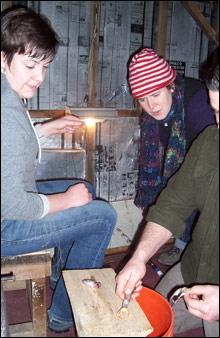
LEARNING TO GUT FISH: The students pay careful attention.
View the full slideshow. |
The cluster of small shacks that comprise Jim's Smelt Camp in Bowdoinham look like a tiny shantytown; were that it was so — I would move right in.
I went smelting for the first time earlier this month with a group of four friends. Smelting, of course, is a fancy word for a certain kind of ice fishing, in which the desired catch is the aquatic species known as smelt. Smelt are silvery fish that measure, on average, between 5 and 8 inches long. They congregate in brackish, salty-fresh waters, like those in Merrymeeting Bay, near Bowdoinham. They are akin to salmon, but smaller (and less pink).
Smelting, though, is also shorthand for initiation into a part of authentic Maine culture. It's been called "one of the most popular rites of winter" by the Portland Press Herald, and "a deep and dependable tradition on the state's coast" by the New York Times. The silly and charming Smelt Fishing In America won director David Camlin the Best Documentary award in the Portland Phoenix's 2007 Maine Short Film Festival mostly because it captured how special this ordinary activity could be. But the most important endorsement came by way of the true Maine outdoorsmen I know — almost all of whom count smelting as one of their favorite, and most fondly remembered, winter pastime.
I can see why. From the moment I arrived at the wooden-floored, tin-walled shack atop the icy river, I felt enveloped by warmth, and not just that emanating from the rusty, rickety, wood-burning stove against one wall. It was also the feeling of camaraderie that comes from sharing a 10-by-10 space with four other people for several hours, all while cracking beers and jokes, and — oh yeah, catching fish.
Because that is the point, as easy as it is to forget when you're having so much fun: We were there to hook smelt. Which we did by paying $15 per person for bait (and use of the cabin, and wood for the stove) and then attaching pieces of said bait — bloodworms! — to hooks, which hung at the end of lines, which were strung from spring-mounted beams, one on each side of the cabin. The lines dipped into rectangular "race holes" cut out of the thick ice. Every once in a while, a baited line (there were eight on each side) would jiggle, at which point the closest smelter would leap toward it, and frantically pull it up to the surface. About half the time, a smelt would be hanging from the end (the other half of the time, it was a false alarm, or the fish got away).
If a smelt was dangling from the line, it was de-hooked — while being called any number of adorable nicknames, such as "Buddytown" or "Sweetie Pie" — and tossed into a five-gallon bucket. Over the course of approximately four hours, the five of us added close to 100 smelt to that bucket. We only ate seven of them (the rest we split up and brought home to be frozen, or made into smelt jerky).